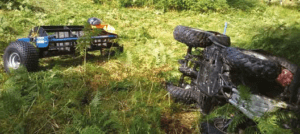These can be an efficient way to distribute materials and reduce the manual handling of carrying them ourselves.
However, we must make sure of the safety of their operation. This comes down to three things:
- Safe Site – When we looked at our own history of quad safety most reported incidents involved an overturn. The root cause in some cases was the suitability of the access tracks provided. Recent discussion in the industry has centred on sit-aside machines with ROPS being a safer alternative, but this carries an issue of access tracks not being wide enough to allow their use.
Whatever machine is to be used you need to clarify the answers to the following questions:
? Has the access track been assessed as suitable and safe? It is good practice for the competent machine operator to be part of this assessment.
? When creating new tracks are they being constructed to accommodate sit- aside machines?
- Safe Machine – Is the quad/ATV designed for forestry use? Has it been maintained in a safe condition? Are operator inspections undertaken and sufficient records kept? Tilhill can supply contractors with check books for both ATV’s and quads.
- Safe Operator – A competent operator needs to demonstrate three things:
1. Training and qualification
2. Experience, and
3. Safe practice.
When considering operators of any plant or machinery we must ensure those operating them are competent. The three items above build in stages.
First comes training and then an assessment to show they have reached a known and agreed standard. Alongside this, and post qualification, comes experience, the level of supervision required whilst gaining experience will depend on how far along the route the operator is and the level of competence being displayed.
For a company taking on or letting an operator work on site they must check the former is in place but must still also check to see the operator is displaying safe practice. Keep a record in site diaries or more formal assessment forms.
Riding an ATV/Quad requires a lot of body movement so do some warm-up stretches to help prevent muscle strain. Gloves are useful for protection and handlebar muffs can help to keep hands warm in cold weather. Wear sturdy, ankle-supporting, footwear that is strong, supportive and has good wet grip. Protect your eyes from insects and branches with either a visor or goggles and ALWAYS WEAR SUITABLE HEAD PROTECTION.
Too many people have been killed or injured in incidents involving Quads. According to HSE statistics there have been 14 deaths in Agriculture, Forestry & Fishing involving quads/ATVs between 2017/18 and 2021/22. Proper planning will minimise the risk and prevent further needless loss of life.
Remember!
If the ATV/Quad has sat unused for several months, you should give it a thorough inspection before using it again for the first time.
Consider:
Fuel – old fuel that has been left in fuel tank can become stale, it may need to be refreshed.
Oil – Check the oil level before each ride, looking at the fluid on the dipstick can tell you how much oil you’ve got and if it is fit for use.
Tyres – You must ensure your tyres are at the right pressure for the terrain and have good tread. It’s also advisable to check for damage to the sidewalls.
Brakes – Brake pads should have enough friction material and they should never be metal to metal. Check pad wear and brake operation.
Steering – Having control of your ATV is essential. The tie rod ends (steering connections to the wheels) are wearable and if one breaks you could be left with just one wheel controlling your ATV.
Contact Points – Check the handlebar grips. If the grips are falling apart then replace them. Ensure foot pegs are secure and in good order and the seat pad is secure.




